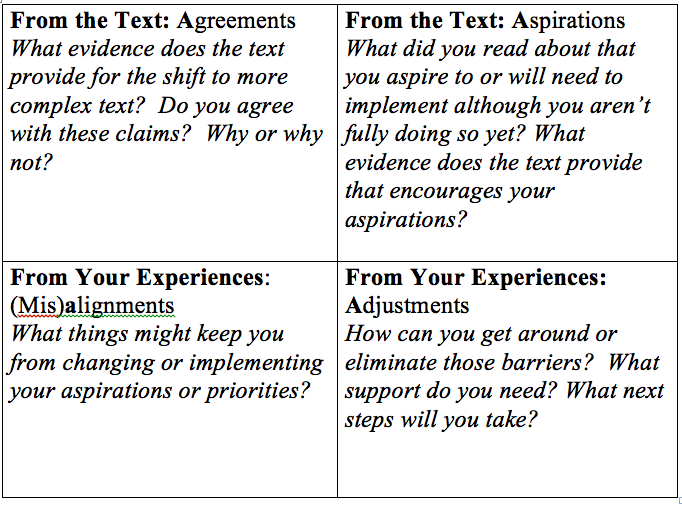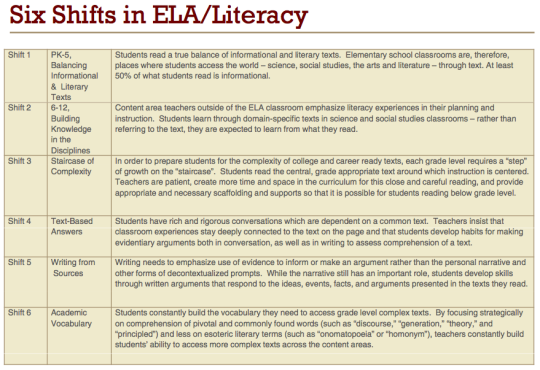There was a time when science, social studies, and other non-English Language Arts teachers were exempt from teaching literacy in their classes. Aside from performance based subjects (arts, tech…), rote memorization of content was mattered greatly and the notion of close reading, writing from sources, text-based evidence, and disparate viewpoints and positions was unfathomed. For many, chugging through the core curricula via a favorite textbook or select set of readings got one from September to June. Fast forward to the Common Core State Standards era and today EVERYONE has responsibility to teach literacy within their subject areas. Not surprisingly, teachers are embracing the changes when given adequate time to develop the necessary understandings and skills literacy instruction require.
To help educators make the shift to literacy instruction, last week a friend and colleague of mine at Capital Region BOCES presented a session on Climate Change and the Common Core to a group of 25 science, social studies, and ELA teachers (Six participants were MST students from SUNY Plattsburgh at Queensbury). Laura Lehtonen is the BOCES Science Director, and like me, strives to help educators incorporate rigor and relevance into classroom instruction while also meeting state-mandated curricula. For our workshop, we decided to look at the Common Core Literacy Instructional Shifts through the lens of Climate Change. Climate change was our chosen topic given the misinformation, confusion, and at times, ignorance about climate change swirling among this great nation’s populace.
Our day began with a 90 minute Climate Reality presentation which describes the process of global warming and the impacts of climate change on extreme weather and drought events, rising sea levels, melting of glaciers and ice caps, dwindling food production and potable water supplies, and spread of tropical diseases. We followed the melancholic Climate Reality session with the Common Core Instructional Shifts, and then had participants practice a number of fun and engaging literacy-based strategies.
Participants investigated and interpreted the message of climate change cartoons, practiced and responded to text-based questions, jigsawed a Royal Society publication on Climate Change and Causes, and reviewed evidence based claims. My favorite activity was the 4 A’s protocol (see below) from EngageNY which includes close reading, text-dependent questioning, use of evidence, and discussion strategies required by the Common Core. For that activity, participants evaluated first the Climate Reality presentation given in the morning, and in the afternoon an opinion piece by Charles Krauthammer Op-Ed piece, Observing ‘settled science’. Though one may not agree with another’s opinions, it matters little without critical inspection of the piece (think close reading, evidence based facts… ala 4A’s Protocol).
Armed with a good understanding of climate change, our participants scrutinized Krauthammer’s op-ed piece and found a number of assumptions made by the author including confusing “unsettled science” correlations of climate change science and mammogram studies, changing climate change predictions as a flaw of climate prediction models, suggesting climate change scientists spend all their time in white lab coats in front of computer screens, and citing one physicist’s interpretations of climate change as a non-urgent matter while disregarding 98% of the world’s scientists including those on the Intergovernmental Panel on Climate Change who state climate change is a problem and anthropogenic in origin. There was agreement that climate change science is complicated, and some participants were interested in checking Krauthammer’s data more deeply, including claims that global temperature hasn’t risen in 15 years or that there are fewer intense tornadoes than in previous years.
The beauty of close reading, text-based evidence, and other shifts of the Common Core State Standards is the promotion of critical thinking. Charles Krauthammer is an excellent writer, and it was an interesting and satisfying experience for participants to use what they learned to verify facts from fiction. Whatever the topic one teaches, the beauty of the Common Core State Standards (CCSS) for non-ELA teachers is the opportunity to engage students in greater rigor and relevant activities. Activities that demand students read text closely and use evidence to support their positions, whatever their positions may be. By implementing CCSS, we are in effect empowering students to use evidence to speak, read, and write with conviction. And that’s a very good thing for the future of our global society.

